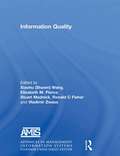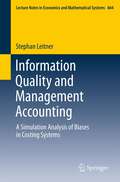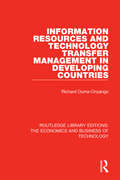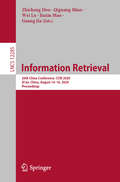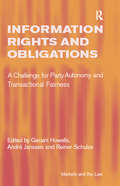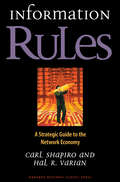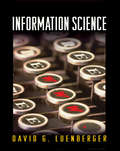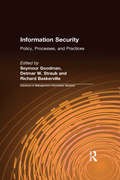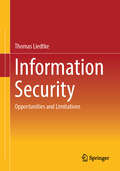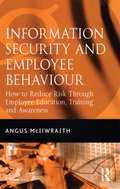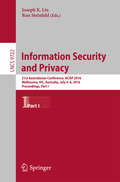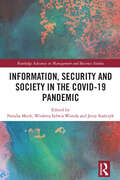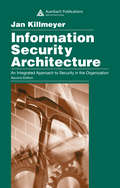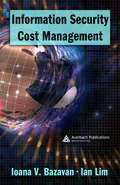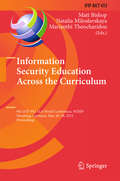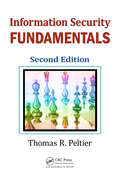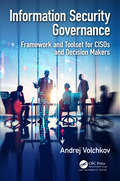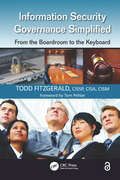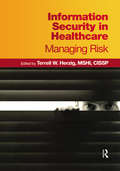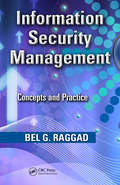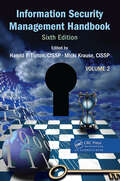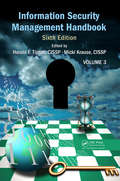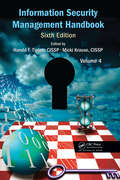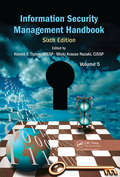- Table View
- List View
Information Quality (Advances In Management Information Systems Ser.)
by Richard Y. Wang Elizabeth M. Pierce Stuart E. Madnick Craig W. FisherOrganizations today have access to vast stores of data that come in a wide variety of forms and may be stored in places ranging from file cabinets to databases, and from library shelves to the Internet. The enormous growth in the quantity of data, however, has brought with it growing problems with the quality of information, further complicated by the struggles many organizations are experiencing as they try to improve their systems for knowledge management and organizational memory. Failure to manage information properly, or inaccurate data, costs businesses billions of dollars each year. This volume presents cutting-edge research on information quality. Part I seeks to understand how data can be measured and evaluated for quality. Part II deals with the problem of ensuring quality while processing data into information a company can use. Part III presents case studies, while Part IV explores organizational issues related to information quality. Part V addresses issues in information quality education.
Information Quality and Management Accounting: A Simulation Analysis of Biases in Costing Systems
by Stephan LeitnerOne of the main aims of management accounting is to provide managers with accurate information in order to provide a good basis for decision-making. There is evidence that the information provided by management accounting systems (MAS) is distorted and the occurrence of biases in accounting information is widely accepted among users of MAS. At the same time, the intensity and the frequency of use of MAS increase, too. Consequently, the quality of the provided information is critical. The focus of this simulation study is twofold. On the one hand, the impact of the sophistication of traditional costing systems on error propagation in the case of a set of input biases is investigated. On the other hand, the impact of single and multiple input biases on the quality of the information provided by traditional costing systems is focused. In order to investigate the research questions, a simulation approach is applied.
Information Resources and Technology Transfer Management in Developing Countries (Routledge Library Editions: The Economics and Business of Technology #34)
by Richard OnyangoOriginally published in 1997, this book puts information management in the context of technology transfer, industrialization and national development. As well as showing the necessity for the efficient use of information resources, the book also examines the costs of poor information management in undermining negotiation, the preparation of contingencies and the ability to let go of 'dead projects'. The book includes case studies of two technology transfer projects in Kenya are included.
Information Retrieval: 26th China Conference, CCIR 2020, Xi'an, China, August 14–16, 2020, Proceedings (Lecture Notes in Computer Science #12285)
by Zhicheng Dou Qiguang Miao Wei Lu Jiaxin Mao Guang JiaThis book constitutes the refereed proceedings of the 26th China Conference on Information Retrieval, CCIR 2020, held in Xi'an, China, in August 2020.*The 12 full papers presented were carefully reviewed and selected from 102 submissions. The papers are organized in topical sections: search and recommendation, NLP for IR, and IR in finance. * Due to the COVID-19 pandemic the conference was held online supplemented with local on-site events.
Information Rights and Obligations: A Challenge for Party Autonomy and Transactional Fairness (Markets and the Law)
by André JanssenInformation requirements have become a key element of consumer policy at the European level and are also gaining increasing importance in all other areas of private law. The law stipulates that information provided should not be misleading and also involves requirements regarding the fairness and objectivity of what has been provided. In addition to controlling the veracity of what is voluntarily offered by traders, the law increasingly requires disclosure of certain information. This volume focuses especially on the question of how these information requirements influence the party autonomy. International contributors explore in various contexts whether the legislative policy regarding the information requirements and their relationship to party autonomy has been properly thought through.
Information Rules
by Hal R. Varian Carl ShapiroIn Information Rules, authors Shapiro and Varian reveal that many classic economic concepts can provide the insight and understanding necessary to succeed in the information age. They argue that if managers seriously want to develop effective strategies for competing in the new economy, they must understand the fundamental economics of information technology. Whether information takes the form of software code or recorded music, is published in a book or magazine, or even posted on a website, managers must know how to evaluate the consequences of pricing, protecting, and planning new versions of information products, services, and systems. The first book to distill the economics of information and networks into practical business strategies, Information Rules is a guide to the winning moves that can help business leaders navigate successfully through the tough decisions of the information economy.
Information Science
by David G. LuenbergerFrom cell phones to Web portals, advances in information and communications technology have thrust society into an information age that is far-reaching, fast-moving, increasingly complex, and yet essential to modern life. Now, renowned scholar and author David Luenberger has produced Information Science, a text that distills and explains the most important concepts and insights at the core of this ongoing revolution. The book represents the material used in a widely acclaimed course offered at Stanford University. Drawing concepts from each of the constituent subfields that collectively comprise information science, Luenberger builds his book around the five "E's" of information: Entropy, Economics, Encryption, Extraction, and Emission. Each area directly impacts modern information products, services, and technology--everything from word processors to digital cash, database systems to decision making, marketing strategy to spread spectrum communication. To study these principles is to learn how English text, music, and pictures can be compressed, how it is possible to construct a digital signature that cannot simply be copied, how beautiful photographs can be sent from distant planets with a tiny battery, how communication networks expand, and how producers of information products can make a profit under difficult market conditions. The book contains vivid examples, illustrations, exercises, and points of historic interest, all of which bring to life the analytic methods presented: Presents a unified approach to the field of information science Emphasizes basic principles Includes a wide range of examples and applications Helps students develop important new skills Suggests exercises with solutions in an instructor's manual
Information Security: Policy, Processes, and Practices (Advances In Management Information Systems Ser. #42)
by Seymour Goodman Detmar W. Straub Richard BaskervilleInformation security is everyone's concern. The way we live is underwritten by information system infrastructures, most notably the Internet. The functioning of our business organizations, the management of our supply chains, and the operation of our governments depend on the secure flow of information. In an organizational environment information security is a never-ending process of protecting information and the systems that produce it.This volume in the "Advances in Management Information Systems" series covers the managerial landscape of information security. It deals with how organizations and nations organize their information security policies and efforts. The book covers how to strategize and implement security with a special focus on emerging technologies. It highlights the wealth of security technologies, and also indicates that the problem is not a lack of technology but rather its intelligent application.
Information Security: Opportunities and Limitations
by Thomas LiedtkeThis book explains the most important technical terms and contents and assigns them to the corresponding areas. It also includes seemingly peripheral areas that play a role in information security. For instance, the topic complexes of functional Safety and Privacy are examined in terms of their similarities and differences. The book presents currently used attack patterns and how to protect against them. Protection must be implemented on both a technical level (e.g., through the use of cryptography) and on an organizational and personnel level (e.g., through appropriate management systems and awareness training). How can one determine how secure data is? How can relevant threats be identified that need protection? How do risk analyses proceed?
Information Security and Employee Behaviour: How to Reduce Risk Through Employee Education, Training and Awareness
by Angus McIlwraithResearch suggests that between 60-75% of all information security incidents are the result of a lack of knowledge and/or understanding amongst an organization's own staff. And yet the great majority of money spent protecting systems is focused on creating technical defences against external threats. Angus McIlwraith's book explains how corporate culture affects perceptions of risk and information security, and how this in turn affects employee behaviour. He then provides a pragmatic approach for educating and training employees in information security and explains how different metrics can be used to assess awareness and behaviour. Information security awareness will always be an ongoing struggle against complacency, problems associated with new systems and technology, and the challenge of other more glamorous and often short term priorities. Information Security and Employee Behaviour will help you develop the capability and culture that will enable your organization to avoid or reduce the impact of unwanted security breaches.
Information Security and Employee Behaviour: How to Reduce Risk Through Employee Education, Training and Awareness
by Angus McIlwraithResearch conducted over many years suggests that between 60 and 85 per cent of all information security incidents are the result of a lack of knowledge and/or understanding amongst an organisation's own people. And yet the great majority of money spent protecting systems is focused on creating technical defences against often exaggerated external threats. Angus McIlwraith's book explains how corporate culture affects perceptions of risk and information security, and how this in turn affects employee behaviour. He then provides a pragmatic approach for educating and training employees in information security and explains how different metrics can be used to assess awareness and behaviour. Information security awareness will always be an ongoing struggle against complacency, problems associated with new systems and technology, and the challenge of other more glamorous and often short-term priorities. Information Security and Employee Behaviour will help you develop the capability and culture that will enable your organisation to avoid or reduce the impact of unwanted security breaches. This second edition has been thoroughly updated throughout, incorporating other areas like anthropology and other non-technical disciplines which are making an impact on recent developments. It also explores the technology used to deliver communication, education and awareness, particularly in the areas of online delivery and recent developments such as ‘gamification’, as well as the ways in which the research, tools, techniques and methodologies relating to the measurement and change of organisational culture have matured.
Information Security and Privacy: 21st Australasian Conference, ACISP 2016, Melbourne, VIC, Australia, July 4-6, 2016, Proceedings, Part I (Lecture Notes in Computer Science #9722)
by Joseph K. Liu Ron SteinfeldThe two-volume set LNCS 9722 and LNCS 9723 constitutes the refereed proceedings of the 21st Australasian Conference on Information Security and Privacy, ACISP 2016, held in Melbourne, VIC, Australia, in July 2016. The 52 revised full and 8 short papers presented together with 6 invited papers in this double volume were carefully revised and selected from 176 submissions. The papers of Part I (LNCS 9722) are organized in topical sections on National Security Infrastructure; Social Network Security; Bitcoin Security; Statistical Privacy; Network Security; Smart City Security; Digital Forensics; Lightweight Security; Secure Batch Processing; Pseudo Random/One-Way Function; Cloud Storage Security; Password/QR Code Security; and Functional Encryption and Attribute-Based Cryptosystem. Part II (LNCS 9723) comprises topics such as Signature and Key Management; Public Key and Identity-Based Encryption; Searchable Encryption; Broadcast Encryption; Mathematical Primitives; Symmetric Cipher; Public Key and Identity-Based Encryption; Biometric Security; Digital Forensics; National Security Infrastructure; Mobile Security; Network Security; and Pseudo Random/One-Way Function.
Information, Security and Society in the COVID-19 Pandemic (Routledge Advances in Management and Business Studies)
by Natalia Moch Wioletta Sylwia Wereda Jerzy StańczykThe COVID-19 pandemic has forced society to re-evaluate security, crisis and risk management principles and policies so we are better prepared to deal with contemporary threats. This book provides an overview of selected and key changes that have taken place in the security environment across entities. The book analyzes the impact of the COVID-19 pandemic on the security environment and modern societies. Using a holistic, interdisciplinary approach to security issues, it draws attention to political, military, cultural, information, legal, psychological and social aspects. Combining theoretical, empirical and practical perspectives, the editors and contributors present the result of research on both current and forecast effects of the pandemic on individuals, social groups, countries and the international community. This edited collection will be directly relevant for researchers and academics across a range of management disciplines, including risk, crisis and security management, information management and related fields.
Information Security Architecture: An Integrated Approach to Security in the Organization, Second Edition
by Jan KillmeyerInformation Security Architecture, Second Edition incorporates the knowledge developed during the past decade that has pushed the information security life cycle from infancy to a more mature, understandable, and manageable state. It simplifies security by providing clear and organized methods and by guiding you to the most effective resources avai
Information Security Cost Management
by Ioana V. Bazavan Ian LimWhile information security is an ever-present challenge for all types of organizations today, most focus on providing security without addressing the necessities of staff, time, or budget in a practical manner.Information Security Cost Management offers a pragmatic approach to implementing information security, taking budgetary and real
Information Security Education Across the Curriculum: 9th IFIP WG 11.8 World Conference, WISE 9, Hamburg, Germany, May 26-28, 2015, Proceedings (IFIP Advances in Information and Communication Technology #453)
by Matt Bishop Natalia Miloslavskaya Marianthi TheocharidouThis book constitutes the refereed proceedings of the 9th IFIP WG 11.8 World Conference on Security Education, WISE 9, held in Hamburg, Germany, in May 2015. The 11 revised papers presented together with 2 invited papers were carefully reviewed and selected from 20 submissions. They are organized in topical sections on innovative methods, software security education, tools and applications for teaching, and syllabus design.
Information Security Fundamentals
by Thomas R. PeltierDeveloping an information security program that adheres to the principle of security as a business enabler must be the first step in an enterprise's effort to build an effective security program. Following in the footsteps of its bestselling predecessor, Information Security Fundamentals, Second Edition provides information security professionals w
Information Security Governance: Framework and Toolset for CISOs and Decision Makers
by Andrej VolchkovThis book presents a framework to model the main activities of information security management and governance. The same model can be used for any security sub-domain such as cybersecurity, data protection, access rights management, business continuity, etc.
Information Security Governance Simplified: From the Boardroom to the Keyboard
by Todd FitzgeraldSecurity practitioners must be able to build a cost-effective security program while at the same time meet the requirements of government regulations. This book lays out these regulations in simple terms and explains how to use the control frameworks to build an effective information security program and governance structure. It discusses how organizations can best ensure that the information is protected and examines all positions from the board of directors to the end user, delineating the role each plays in protecting the security of the organization.
Information Security in Healthcare: Managing Risk (HIMSS Book Series)
by Terrell W. HerzigInformation Security in Healthcare is an essential guide for implementing a comprehensive information security management program in the modern healthcare environment. Combining the experience and insights of top healthcare IT managers and information security professionals, this book offers detailed coverage of myriad
Information Security Management: Concepts and Practice
by Bel G. RaggadInformation security cannot be effectively managed unless secure methods and standards are integrated into all phases of the information security life cycle. And, although the international community has been aggressively engaged in developing security standards for network and information security worldwide, there are few textbooks available that
Information Security Management Handbook, Volume 2
by Harold F. Tipton Micki KrauseA compilation of the fundamental knowledge, skills, techniques, and tools require by all security professionals, Information Security Handbook, Sixth Edition sets the standard on which all IT security programs and certifications are based. Considered the gold-standard reference of Information Security, Volume 2 includes coverage of each domain of t
Information Security Management Handbook, Volume 3 ((ISC)2 Press)
by Harold F. Tipton Micki KrauseEvery year, in response to new technologies and new laws in different countries and regions, there are changes to the fundamental knowledge, skills, techniques, and tools required by all IT security professionals. In step with the lightning-quick, increasingly fast pace of change in the technology field, the Information Security Management Handbook
Information Security Management Handbook, Volume 4
by Harold F. Tipton Micki KrauseEvery year, in response to advancements in technology and new laws in different countries and regions, there are many changes and updates to the body of knowledge required of IT security professionals. Updated annually to keep up with the increasingly fast pace of change in the field, the Information Security Management Handbook is the single most
Information Security Management Handbook, Volume 5
by Harold F. Tipton Micki Krause NozakiUpdated annually to keep up with the increasingly fast pace of change in the field, the Information Security Management Handbook is the single most comprehensive and up-to-date resource on information security (IS) and assurance. Facilitating the up-to-date understanding required of all IS professionals, the Information Security Management Handbook
